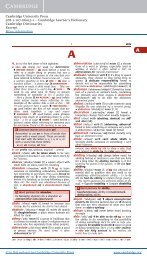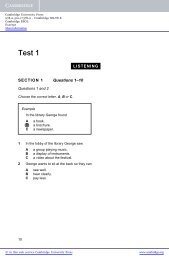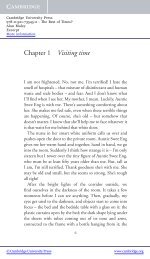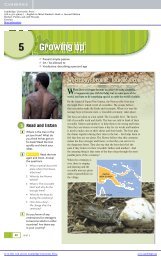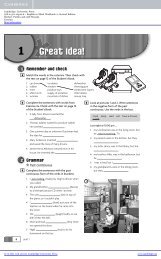UNIT 10 Pushing the boundaries
UNIT 10 Pushing the boundaries
UNIT 10 Pushing the boundaries
You also want an ePaper? Increase the reach of your titles
YUMPU automatically turns print PDFs into web optimized ePapers that Google loves.
Cambridge University Press<br />
978-0-521-71518-8 - Cambridge English for Engineering<br />
Mark Ibbotson<br />
Excerpt<br />
More information<br />
78<br />
<strong>UNIT</strong> <strong>10</strong> <strong>Pushing</strong> <strong>the</strong> <strong>boundaries</strong><br />
� Discussing performance and<br />
suitability<br />
� Describing physical forces<br />
� Discussing relative performance<br />
� Describing capabilities and<br />
limitations<br />
Discussing performance and suitability<br />
1 a In pairs, answer <strong>the</strong> following questions about wind turbines.<br />
1 What function do wind turbines perform?<br />
2 What are <strong>the</strong> main advantages and disadvantages of wind turbines?<br />
3 What types of location are most suitable for wind farms?<br />
b In pairs, discuss <strong>the</strong> functions and technical characteristics of <strong>the</strong> following<br />
wind turbine components.<br />
blades tower generator<br />
2 a <strong>10</strong>.1 Mike, Loreta and Hanif, engineers at a wind turbine constructor, are<br />
discussing performance and suitability issues relating to offshore wind<br />
turbines. Listen to <strong>the</strong> conversation and answer <strong>the</strong> following questions.<br />
1 Which wind turbine component do <strong>the</strong> engineers discuss?<br />
2 What is <strong>the</strong> big problem with offshore installations?<br />
3 Which two types of construction material are being compared?<br />
4 Why are coastal defences mentioned?<br />
5 What point does Hanif make about regular maintenance?<br />
6 What comparison needs to be made with regard to lifespan?<br />
b Match <strong>the</strong> words (1–6) from <strong>the</strong> discussion to <strong>the</strong> defi nitions (a–f).<br />
1 appropriate/suitable a <strong>the</strong> right solution for a particular situation<br />
2 consistent/reliable b good enough for <strong>the</strong> intended function<br />
3 cost-effective/economical c performs a function well<br />
4 effective d works quickly and well<br />
5 effi cient e makes <strong>the</strong> most of resources, isn’t wasteful<br />
6 suffi cient/adequate f doesn’t break down, always performs in <strong>the</strong> same way<br />
c Make <strong>the</strong> following words negative by adding <strong>the</strong> prefi xes in- or un-.<br />
1 adequate ���������� 6 effi cient<br />
2 appropriate 7 reliable<br />
3 consistent 8 suffi cient<br />
4 economical<br />
5 effective<br />
9 suitable<br />
Unit <strong>10</strong> <strong>Pushing</strong> <strong>the</strong> <strong>boundaries</strong><br />
© Cambridge University Press www.cambridge.org
Cambridge University Press<br />
978-0-521-71518-8 - Cambridge English for Engineering<br />
Mark Ibbotson<br />
Excerpt<br />
More information<br />
d <strong>10</strong>.1 Listen again. What issues do Mike, Loreta and Hanif agree and<br />
disagree on?<br />
3 a The following information is from <strong>the</strong> web site of Sigma Power, a fi rm<br />
that advises corporate and government clients on wind energy projects.<br />
Complete <strong>the</strong> text using <strong>the</strong> words in Exercise 2c.<br />
Wind Turbines - FACT FILE<br />
1 The fact that wind turbines consume no fuel and waste very little energy is clearly a fundamental<br />
advantage. But just how ��������� are <strong>the</strong>y? Key fi gures<br />
2 Clearly, wind turbines need to be located on relatively windy sites in order to function. From a<br />
meteorological standpoint, what kinds of geographical location are <strong>the</strong> most ?<br />
3 Turbines are generally placed at <strong>the</strong> tops of tall towers, where wind speeds are higher, thus<br />
making <strong>the</strong>m more . What o<strong>the</strong>r positioning factors infl uence performance?<br />
4 Wind turbines rarely function continuously, due to <strong>the</strong> fact that wind speeds are<br />
How signifi cant is <strong>the</strong> impact of variable wea<strong>the</strong>r conditions on power generating capacity?<br />
.<br />
5 Transmitting electricity over long distances is inherently , due to power loss from<br />
overhead or underground power lines. Find out more about <strong>the</strong> advantages of generating<br />
power locally.<br />
6 The generating capacity of wind turbines is generally for it to be relied upon<br />
<strong>10</strong>0%. What percentage of total generating capacity can wind turbines realistically provide?<br />
7 Some early wind turbines were , suffering breakdowns caused by inaxial<br />
stresses stemming from higher wind loads on <strong>the</strong> upper blade. However, this problem has been<br />
overcome on modern units. Learn more about <strong>the</strong> technical evolution of wind turbines.<br />
b You are engineers at Sigma Power. The marketing manager has asked<br />
you to provide some technical answers for <strong>the</strong> frequently asked questions<br />
section of <strong>the</strong> company’s website. The FAQ section is aimed primarily at<br />
potential clients who are thinking of installing wind turbines at <strong>the</strong>ir sites<br />
– factories, offi ce complexes, hospitals, and university campuses. In pairs,<br />
discuss <strong>the</strong> following questions and write <strong>the</strong> answers for <strong>the</strong> website using<br />
<strong>the</strong> information in <strong>the</strong> fact fi le and your own knowledge.<br />
Frequently Asked Questions<br />
A common-sense introduction to wind turbines<br />
1 What’s <strong>the</strong> big advantage of having a wind turbine at my site?<br />
2 How dependable are wind turbines as a source of power, given that wea<strong>the</strong>r conditions are<br />
changeable?<br />
3 What kinds of site are most suitable for wind turbines, relative to natural factors such as<br />
hills, <strong>the</strong> coast, and height above sea level?<br />
4 What’s <strong>the</strong> most appropriate location for my wind turbine, relative to local features on <strong>the</strong><br />
site, such as trees and buildings?<br />
Unit <strong>10</strong> <strong>Pushing</strong> <strong>the</strong> <strong>boundaries</strong><br />
© Cambridge University Press www.cambridge.org<br />
79
Cambridge University Press<br />
978-0-521-71518-8 - Cambridge English for Engineering<br />
Mark Ibbotson<br />
Excerpt<br />
More information<br />
80<br />
Describing physical forces<br />
4 a Read <strong>the</strong> following article. What is a solar tower and how does it use <strong>the</strong><br />
forces of expansion and pressure?<br />
�������������<br />
������������<br />
�������������<br />
����������<br />
�������<br />
b What physical forces would act on a solar tower 1km high?<br />
c <strong>10</strong>.2 Su, a structural engineer specialising in <strong>the</strong> design of very tall<br />
structures, is giving a talk to a group of engineering students. Listen to <strong>the</strong><br />
talk. Which of <strong>the</strong> forces in <strong>the</strong> box doesn’t she mention?<br />
bending centrifugal force compression contraction expansion<br />
friction pressure shear tension torsion/torque<br />
d Label <strong>the</strong> diagrams using <strong>the</strong> forces in Exercise 4c.<br />
1 2 3 4 5<br />
������������<br />
6 7 8 9 <strong>10</strong><br />
Unit <strong>10</strong> <strong>Pushing</strong> <strong>the</strong> <strong>boundaries</strong><br />
�������������������������������������������������������<br />
��������������������������������������������������������������<br />
���������������������������������������������������������<br />
������������������������������������������������������������<br />
�������������������������������������������������������<br />
��������������������������������������������������������<br />
������������������������������������������������������������<br />
���������������������������������������������������������<br />
����������������������������������������������������<br />
�������������������������������������������������������������<br />
�������������������������������������������������������<br />
��������������������������������������������������������������<br />
�����������������������������������<br />
������������<br />
����������������������������������������������������������������<br />
����������������������������������������������������������<br />
�������������������������������������������������������������<br />
������������������������������������������������������������<br />
������������������������������������������������������������<br />
������������������������������������������������������������<br />
������������������������������������������������������������<br />
�������������������������������������������������������������<br />
�����������������������������������������������������������<br />
© Cambridge University Press www.cambridge.org
Cambridge University Press<br />
978-0-521-71518-8 - Cambridge English for Engineering<br />
Mark Ibbotson<br />
Excerpt<br />
More information<br />
e <strong>10</strong>.2 Complete <strong>the</strong> following sentences from <strong>the</strong> talk using <strong>the</strong> forces in<br />
Exercise 4c. Listen again and check your answers.<br />
1 So that downward force means <strong>the</strong> structure is in ������������, especially<br />
near <strong>the</strong> bottom.<br />
2 … a horizontal load, exerted by air<br />
structure.<br />
against one side of <strong>the</strong><br />
3 Because <strong>the</strong> structure is fi xed at ground level, and free at <strong>the</strong> top, that<br />
generates forces.<br />
4 … when elements bend, you have opposing forces:<br />
at <strong>the</strong> o<strong>the</strong>r.<br />
at one side,<br />
5 … <strong>the</strong> wind effectively tries to slide <strong>the</strong> structure along <strong>the</strong> ground, and <strong>the</strong><br />
foundations below <strong>the</strong> ground resist that. The result of that is<br />
force …<br />
6 … <strong>the</strong> foundations need to rely on<br />
pull-out force, …<br />
with <strong>the</strong> ground to resist <strong>the</strong><br />
7 The action of <strong>the</strong> wind can also generate<br />
force …<br />
. You get a twisting<br />
8 When concrete absorbs heat from <strong>the</strong> sun, you get ; as soon as <strong>the</strong><br />
sun goes in, <strong>the</strong>re’s .<br />
f You and your partner specialise in designing structures for electrical<br />
transmission grids. You are currently working on a cable support concept<br />
for power lines near wind farms exposed to severe wea<strong>the</strong>r. You have come<br />
up with <strong>the</strong> following design. In pairs, hold a short meeting to evaluate your<br />
design concept. Explain <strong>the</strong> forces acting on <strong>the</strong> structure.<br />
Severe wea<strong>the</strong>r cable support concept<br />
wind direction 1<br />
wind direction 2<br />
column 1<br />
leg 1<br />
beam<br />
column 2<br />
leg 3<br />
leg 2<br />
pivoting<br />
insulators<br />
leg 4<br />
concrete<br />
foundations<br />
cables<br />
Unit <strong>10</strong> <strong>Pushing</strong> <strong>the</strong> <strong>boundaries</strong><br />
© Cambridge University Press www.cambridge.org<br />
81
Cambridge University Press<br />
978-0-521-71518-8 - Cambridge English for Engineering<br />
Mark Ibbotson<br />
Excerpt<br />
More information<br />
82<br />
Discussing relative performance<br />
5 a In pairs, discuss <strong>the</strong> advantages and disadvantages of air and highspeed<br />
rail travel. Focus on trips of between 500km and 1,500km, <strong>the</strong><br />
journey length over which planes and trains often compete for <strong>the</strong> same<br />
passengers.<br />
b Read <strong>the</strong> extract from an article about transport in a popular science and<br />
technology magazine and answer <strong>the</strong> following questions.<br />
1 What factors should be considered in <strong>the</strong> comparative analysis described?<br />
2 What is <strong>the</strong> purpose of <strong>the</strong> comparative analysis?<br />
3 What suggestion is made about Europe?<br />
Speed, convenience, effi ciency, and<br />
environmental-friendliness: four factors<br />
with which to assess <strong>the</strong> relative effectiveness<br />
of different long-distance, mass-transport<br />
solutions for passengers. Technology: <strong>the</strong><br />
key criterion in determining what transport<br />
solutions are available. And distance: <strong>the</strong> main<br />
consideration when categorising routes. Blend<br />
<strong>the</strong>se variables toge<strong>the</strong>r in varying quantities,<br />
and you have a model for calculating <strong>the</strong><br />
optimum way of moving people.<br />
On a European scale, whichever way you mix<br />
<strong>the</strong> various criteria, <strong>the</strong> most advantageous<br />
way of getting people around <strong>the</strong> heart of <strong>the</strong><br />
continent seems to be on high-speed, electric<br />
trains.<br />
c Find words in <strong>the</strong> text in Exercise 5b to match to <strong>the</strong> following defi nitions.<br />
Which one of <strong>the</strong> words has a plural form?<br />
1 standard by which you judge something<br />
2 fact or situation which infl uences <strong>the</strong> result of something<br />
3 number, amount or situation which can change<br />
6 a What do you know about France’s<br />
high-speed train, <strong>the</strong> TGV? What is its<br />
normal operating speed? What is <strong>the</strong><br />
approximate length of <strong>the</strong> train?<br />
b Read <strong>the</strong> facts about <strong>the</strong> world speed<br />
record set by <strong>the</strong> TGV. Compare <strong>the</strong> world<br />
record journey with a normal TGV journey,<br />
using your answers in Exercise 6a.<br />
World Speed Record for an In-Service<br />
Passenger Train<br />
Date April 3, 2007<br />
Location France: Paris to Strasbourg line on<br />
slightly modified track<br />
Train Standard TGV with fewer coaches<br />
Record 574.8 km/h<br />
Unit <strong>10</strong> <strong>Pushing</strong> <strong>the</strong> <strong>boundaries</strong><br />
© Cambridge University Press www.cambridge.org
Cambridge University Press<br />
978-0-521-71518-8 - Cambridge English for Engineering<br />
Mark Ibbotson<br />
Excerpt<br />
More information<br />
c <strong>10</strong>.3 Andrej, a consulting engineer specialising in rail technology, is talking<br />
about <strong>the</strong> TGV world speed record. Listen to <strong>the</strong> talk and answer <strong>the</strong><br />
following questions.<br />
1 Overall, how heavily modified was <strong>the</strong> train?<br />
2 How long was <strong>the</strong> record-breaking TGV?<br />
3 Why was some of <strong>the</strong> bodywork modified?<br />
4 Why was <strong>the</strong> diameter of <strong>the</strong> wheels changed?<br />
d <strong>10</strong>.3 Listen again and complete <strong>the</strong> following table about <strong>the</strong> modified TGV<br />
using <strong>the</strong> figures in <strong>the</strong> box.<br />
+ 68% + 19% – 15% – 50% + 80%<br />
Technical criteria Modified TGV: % difference from standard model<br />
Maximum speed<br />
Train length (with coaches)<br />
Aerodynamic drag<br />
Diameter of wheels<br />
Motor power output<br />
e Complete <strong>the</strong> following sentences from <strong>the</strong> talk by underlining <strong>the</strong> correct<br />
words.<br />
1 The record speed exceeded <strong>the</strong> standard operating speed by a tiny/huge<br />
margin.<br />
2 The train was modified to a certain/considerable extent …<br />
3 … <strong>the</strong> modified train was significantly/slightly shorter, …<br />
4 … changes were made to <strong>the</strong> bodywork, to make it slightly/much more<br />
aerodynamic …<br />
5 The wheels on <strong>the</strong> modified train were marginally/substantially bigger …<br />
6 … <strong>the</strong> power of <strong>the</strong> electric motors was marginally/substantially higher than<br />
<strong>the</strong> standard units …<br />
7 … standard high-speed trains can be made to go faster by a slight/<br />
considerable amount.<br />
f Rewrite <strong>the</strong> following sentences to describe <strong>the</strong> modifications that were<br />
made to <strong>the</strong> TGV for <strong>the</strong> record attempt. Use <strong>the</strong> phrases in Exercise 6e to<br />
replace <strong>the</strong> words in bold.<br />
1 The supply voltage in <strong>the</strong> catenary cables had to be increased from 25,000<br />
to 31,000 volts.<br />
2 To limit oscillation, <strong>the</strong> tension of <strong>the</strong> catenary cables had to be increased by<br />
60%.<br />
3 On some curves, <strong>the</strong> camber of <strong>the</strong> track had to be increased by a few<br />
centimetres.<br />
4 The 574.8km/h record beat <strong>the</strong> previous record, set in 1990, by 59.5 km/h.<br />
5 In perfect conditions <strong>the</strong> TGV could probably have gone faster by 5 to <strong>10</strong><br />
km/h.<br />
7 In pairs, choose a product or type of technology you know well and compare<br />
its performance and quality with an earlier model, describing <strong>the</strong> extent of<br />
<strong>the</strong> differences.<br />
Unit <strong>10</strong> <strong>Pushing</strong> <strong>the</strong> <strong>boundaries</strong><br />
© Cambridge University Press www.cambridge.org<br />
83
Cambridge University Press<br />
978-0-521-71518-8 - Cambridge English for Engineering<br />
Mark Ibbotson<br />
Excerpt<br />
More information<br />
Describing capabilities and limitations<br />
8 a Look at <strong>the</strong> photos and read <strong>the</strong> extracts from The<br />
Story of John Paul Stapp, by Nick T. Spark, and answer<br />
<strong>the</strong> following questions.<br />
1 When and where do you think it took place?<br />
2 What do you think <strong>the</strong> aim of <strong>the</strong> test was?<br />
3 What do you think John Stapp’s profession was?<br />
4 What equipment do you think was used?<br />
5 What do you think happened in <strong>the</strong> experiment?<br />
84<br />
With five seconds to go Stapp activated <strong>the</strong> sled’s movie cameras, and<br />
prepared for <strong>the</strong> shock. Sonic Wind’s nine rockets detonated with a<br />
terrific roar, sending out trails of fire and blasting Stapp down <strong>the</strong> track.<br />
… Sonic Wind hit <strong>the</strong> water brake. The rear of <strong>the</strong> sled tore away. The front<br />
continued, hardly slowing at all until it hit <strong>the</strong> second water brake. Then,<br />
spray exploded from <strong>the</strong> back of Sonic Wind. It stopped like it had hit a<br />
concrete wall.<br />
b <strong>10</strong>.4 Listen to an extract from a documentary about<br />
<strong>the</strong> experiment and check your answers to Exercise 8a.<br />
c Complete <strong>the</strong> following data on <strong>the</strong> Sonic Wind test<br />
using <strong>the</strong> fi gures in <strong>the</strong> box.<br />
1.2 3 20 46 <strong>10</strong>15<br />
1 Max speed: km/h<br />
2 Acceleration from 0 to max speed: seconds<br />
3 Acceleration force: Gs<br />
4 Deceleration time: seconds<br />
5 Deceleration force: Gs<br />
d <strong>10</strong>.5 Listen to <strong>the</strong> next part of <strong>the</strong> documentary and check your answers to<br />
Exercise 8c.<br />
e Complete <strong>the</strong> following groups of synonyms using <strong>the</strong> words in <strong>the</strong> box.<br />
able to capable of cope with exceed incapable of<br />
intended for subjected to surpass unable to withstand<br />
1 exposed to (a force) / ������������<br />
2 resist (a force) / /<br />
3 go beyond (a limit) / /<br />
4 suitable for (a use) /<br />
5 can / /<br />
6 can’t / /<br />
Unit <strong>10</strong> <strong>Pushing</strong> <strong>the</strong> <strong>boundaries</strong><br />
© Cambridge University Press www.cambridge.org
Cambridge University Press<br />
978-0-521-71518-8 - Cambridge English for Engineering<br />
Mark Ibbotson<br />
Excerpt<br />
More information<br />
f Complete <strong>the</strong> following sentences about Sonic Wind using <strong>the</strong> correct form<br />
of <strong>the</strong> words in Exercise 8e.<br />
1 The bolts fi xing <strong>the</strong> camera to <strong>the</strong> sled had to ��������� high shear forces.<br />
2 The sled’s rockets were generating enormous thrust.<br />
3 The pools at <strong>the</strong> end of <strong>the</strong> track were stop <strong>the</strong> sled rapidly.<br />
4 The skids on <strong>the</strong> sled had to high levels of friction.<br />
5 At full speed, John Stapp was several tonnes of air pressure.<br />
6 The rear of <strong>the</strong> sled was resist <strong>the</strong> shock of deceleration, and<br />
broke off.<br />
7 Doctors thought people were surviving forces of 17 Gs and above.<br />
8 John Stapp <strong>the</strong> 17 G limit by a huge margin.<br />
9 a You are a consultant engineer and your fi rm have received an email from an<br />
entrepreneur with an ambitious plan. Read <strong>the</strong> following email extract and<br />
note <strong>the</strong> key information.<br />
b In pairs, discuss <strong>the</strong> key<br />
information in Exercise 9a and<br />
consider <strong>the</strong> following points.<br />
� <strong>the</strong> level of G force<br />
� a safe length for <strong>the</strong> track<br />
� <strong>the</strong> feasibility of using wheels<br />
� <strong>the</strong> suitability of <strong>the</strong> braking<br />
systems suggested<br />
c <strong>10</strong>.6 Jasmine and Andrew,<br />
consulting engineers, are<br />
discussing <strong>the</strong> issues in<br />
Exercise 9b. Listen and compare<br />
what <strong>the</strong>y say with your ideas<br />
from Exercise 9b.<br />
d In pairs, discuss <strong>the</strong> points<br />
raised in <strong>the</strong>ir conversation and<br />
make notes summarising your<br />
thoughts in preparation for a<br />
meeting with <strong>the</strong> entrepreneur.<br />
e Prepare a short presentation<br />
for <strong>the</strong> entrepreneur using your<br />
notes from Exercise 9d. Student<br />
A, you are <strong>the</strong> consultant<br />
engineer. Give <strong>the</strong> presentation.<br />
Student B, you are <strong>the</strong><br />
entrepreneur. Listen and ask<br />
questions about specifi c details.<br />
Swap roles and practise again.<br />
To: Jasmine Murray<br />
Subject: Rocket sled ride<br />
The proposal is to build a rocket sled ride on a desert site in Western<br />
Australia. The ride will be aimed at wealthy tourists, and will allow<br />
<strong>the</strong>m to experience supersonic speeds. We envisage carrying two<br />
passengers at a time, seated behind <strong>the</strong> pilot. The idea is inspired<br />
by <strong>the</strong> Sonic Wind experiments, which I’m sure you’re familiar with.<br />
However, it goes without saying that safety will be <strong>the</strong> number one<br />
priority, which means that extremes of acceleration and deceleration<br />
must be avoided. For instance, a water brake, like <strong>the</strong> one used in<br />
<strong>the</strong> Sonic Wind tests, is clearly out of <strong>the</strong> question.<br />
The site is large enough to accommodate a track up to 16 km<br />
long, though I reckon <strong>10</strong> km would be adequate. According to my<br />
rough calculations, that would be suffi cient to allow progressive<br />
acceleration up to and through <strong>the</strong> sound barrier to about 350 m/s,<br />
and progressive deceleration to a standstill without exceeding 2 G<br />
(20 m/s²), while still leaving three to four kilometres of track as a<br />
safety margin. However, I’m not an engineer, so would appreciate<br />
your professional opinion on that.<br />
In terms of basic technology, I assume <strong>the</strong> most suitable vehicle<br />
would be a rail-mounted sled, with steel skids that grip <strong>the</strong> track,<br />
above and below <strong>the</strong> rails, to prevent derailing, and avoid problems<br />
with aerodynamic lift. I assume wheels wouldn’t be feasible given <strong>the</strong><br />
speeds involved, though I’m not <strong>10</strong>0% sure about that. Perhaps you<br />
can advise. Propulsion would be provided by a rocket or aircraft jet.<br />
I already have a consultant sourcing a suitable engine, however, so<br />
that angle is being looked into.<br />
As far as your input is concerned, <strong>the</strong> main area where I need your<br />
expertise is on <strong>the</strong> braking system. As I said, violent braking is out of<br />
<strong>the</strong> question. As I see it, suitably gentle options include systems that<br />
apply friction to <strong>the</strong> rails, aerodynamic fl aps, parachutes, or reversed<br />
engine thrust. But, again, I’m not an engineer, so I look forward to<br />
discussing your thoughts on <strong>the</strong>se issues.<br />
Unit <strong>10</strong> <strong>Pushing</strong> <strong>the</strong> <strong>boundaries</strong><br />
© Cambridge University Press www.cambridge.org<br />
85



